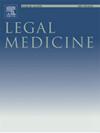Postmortem changes in porcine eyes on computed tomography images
IF 1.3
4区 医学
Q3 MEDICINE, LEGAL
引用次数: 0
Abstract
Porcine eyes were examined using postmortem computed tomography (PMCT) under controlled postmortem time and temperature conditions to assess the mechanisms and timing of changes in ocular structure. Eight porcine heads were halved, and PMCT scans were conducted from postmortem interval (PMI) days 0 to 13. CT images were obtained to evaluate the vitreous volumes, vitreous CT values, axial lengths of the eyes, lens dislocation, and intraocular gas. The vitreous volume decreased over time, with the highest median rate of 17.7 % at PMI 1, followed by 12.0 %, 11.7 %, and 11.3 % at PMIs 6, 7, and 8, respectively. There was a significant decrease in the axial eye length from PMIs 0 to 1, while the transverse diameter remained unchanged. Lens dislocation was observed in all cases at PMI 9. Receiver operating characteristic analysis using the PMI as the predictive value for the presence of lens dislocation revealed a cutoff value of PMI 6, with an area under the curve of 0.98. Intraocular gas was observed in four cases. In two cases with intraocular gas, intravascular gas appeared to be continuous with the intraocular gas via the ciliary body. Lens dislocation occurred 6 days postmortem in porcine eyes at moderate temperatures. Intraocular gas was also observed 6 days postmortem, which may have been caused by the influx of intravascular gas into the eye via the ciliary body. These structural changes in the porcine model, may help in estimating the time of death.
死后猪眼睛的计算机断层图像变化。
在受控的死后时间和温度条件下,使用死后计算机断层扫描(PMCT)检查猪眼,以评估眼结构变化的机制和时间。8个猪头被切成两半,从死后间隔(PMI) 0天到13天进行PMCT扫描。CT图像评估玻璃体体积、玻璃体CT值、眼轴长度、晶状体脱位和眼内气体。玻璃体体积随着时间的推移而减少,PMI 1时的中位率最高,为17.7%,其次是PMI 6、7和8时的12.0%、11.7%和11.3%。眼轴向长度从PMIs 0减小到1,而眼横向直径保持不变。所有病例在PMI 9时均观察到晶状体脱位。使用PMI作为晶状体脱位的预测值进行受者工作特征分析,其截止值为PMI 6,曲线下面积为0.98。4例观察到眼内气体。在两例眼内气体中,血管内气体通过睫状体与眼内气体连续。猪眼死后6天在中等温度下发生晶状体脱位。死后6天还观察到眼内气体,这可能是由于血管内气体通过睫状体流入眼睛引起的。猪模型中的这些结构变化,可能有助于估计死亡时间。
本文章由计算机程序翻译,如有差异,请以英文原文为准。
求助全文
约1分钟内获得全文
求助全文
来源期刊

Legal Medicine
Nursing-Issues, Ethics and Legal Aspects
CiteScore
2.80
自引率
6.70%
发文量
119
审稿时长
7.9 weeks
期刊介绍:
Legal Medicine provides an international forum for the publication of original articles, reviews and correspondence on subjects that cover practical and theoretical areas of interest relating to the wide range of legal medicine.
Subjects covered include forensic pathology, toxicology, odontology, anthropology, criminalistics, immunochemistry, hemogenetics and forensic aspects of biological science with emphasis on DNA analysis and molecular biology. Submissions dealing with medicolegal problems such as malpractice, insurance, child abuse or ethics in medical practice are also acceptable.
 求助内容:
求助内容: 应助结果提醒方式:
应助结果提醒方式:


